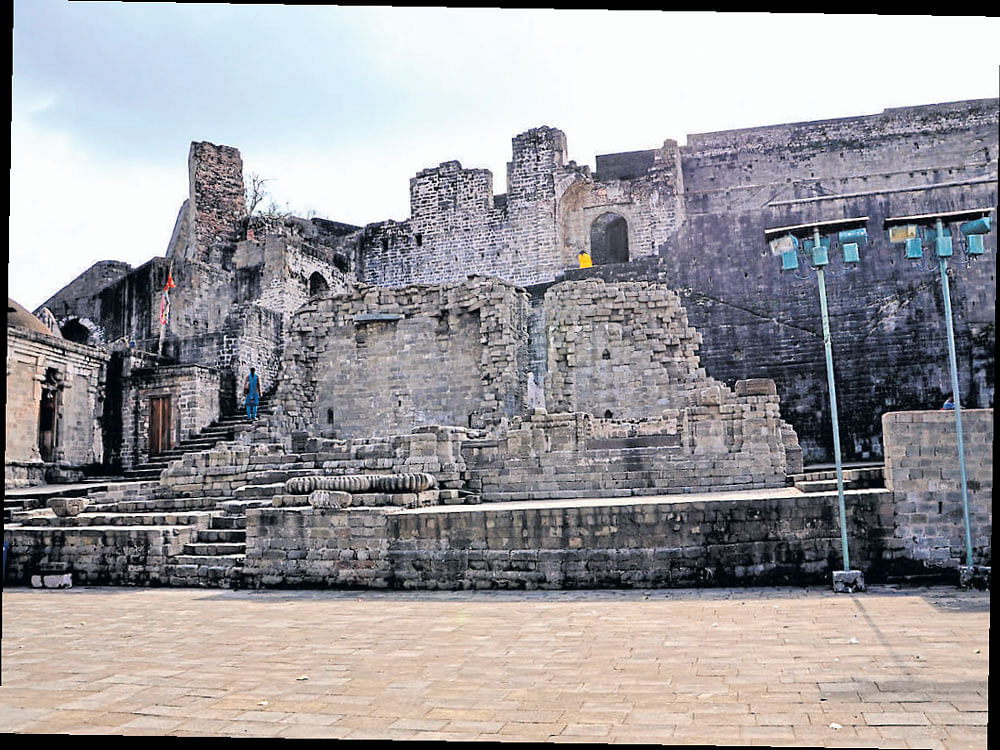
McLeod Ganj — the destination in Dharamshala where we chose to spend a few days of holidays — turned out to be an interesting brush with history. Recently, when we checked into a hotel in McLeod Ganj, the weather was inclement.
The incessant drizzle dampened our spirits. As luck would have it, the next morning, we woke up with sunrays sneaking into our rooms. Hailing a cab, we set out to visit the Kangra Fort.
Our cab driver, Rakesh Kumar, a cheerful middle-aged man, drove us down through the Dharamshala town to the Kangra Fort, some 28 km, in a little over half an hour.
The fort is maintained by the Archaeological Survey of India (ASI), and at the ticket counter, a young damsel regretted that the tickets could not be issued as the internet was not working. After paying the entry fee, we proceeded towards the entry gate. The absence of guides here is amply compensated by the audio-guides being sold by the Maharaja Sansar Chandra Museum.
As to how Kangra got its name, one of the residents of Dharamshala, Dinesh Patel, informed me that ‘kaan’ in Hindi means ears and ‘gada’ means moulding — the place was known for plastic surgeons who excelled in repairing the ears and visages of warriors whose faces were mutilated in battles. Yet another story stated that the place got its name because of the fort (garh) being in the shape of an ear. The fort was once a part of the kingdom of Jalandhar.
It is situated atop a rocky hill encircled by a four-km wall. A magnificent view of the Majhi and Ban Ganga rivers from the top of the fort testify to the strategic acumen in the selection of spot for the fort. Anyone approaching the fort could be spotted from a long distance, giving the inmates of the fort adequate time to prepare themselves to defend it.
Known as Trigarth, meaning three capitals — Multan, Jalandhar and Kangra — till about 11th century, Kangra has also been known as Bhimkot, Nagarkot, Susarmapura and Katoch.
As legends lead...
Legend has it that Bhumi Chandra, the founder of Katoch Dynasty, was born out of the perspiration of Goddess Ambika. While fighting the demon Rakathber, a drop of sweat fell on the ground, giving birth to Bhumi Chandra, who then vanquished the demon. So pleased was Goddess Ambika that she not only gave him a large kingdom, but also conferred on him the title of Katoch, meaning ‘the best in swordsmanship’.
Inside the fort is a temple dedicated to Goddess Ambika; the two other temples are the Lakshmi Narayan Temple and the Jain Adi Narayan Temple.
The fort, believed to be the largest in the region, has been under several attacks. Though not clearly established by historical records, it is said that Mahmud Ghazni succeeded in over-running the fort in 1009. It was in 1337 that Mohammed Tughlaq attacked the fort and captured it. Fourteen years later, it was Feroz Shah Tughlaq, his son, who was comfortably ensconced in the fort.
It was during the reign of Akbar that the fort was attacked as many as 52 times, but the troops of Raja of Kangra bravely held on to the fort by repulsing every onslaught. Finally in 1620, Jehangir, Akbar’s son, successfully attacked the fort after laying siege over it for over 14 months, during which Raja Hari Chand and his family remained confined to the fort. Until then, the fort had the reputation of being impregnable. Jehangir appointed a governor — Nawab Saif Ali Khan — to rule over the place on his behalf and keep the chieftains under control.
Raja Sansar Chand II regained control over the fort after a bitter fight in 1789, and held on to it until the Gurkhas entered and occupied it while the raja was waging a battle with the Sikhs elsewhere. The occupation of the fort by the Gurkhas forced the raja to enter into an alliance with the Sikhs. Aided by the Sikhs under Ranjit Singh, Raja Sansar Chand re-captured the fort and held on to it till 1828, when Ranjit Singh took over the fort after the death of the former.
When the earth shook
The British troops annexed the fort in 1846 and remained in occupation till an earthquake of severe intensity jolted the fort, leaving a major portion of it in shambles. The dilapidated buildings within the fort forced the British troops to vacate it once for all. The ruins now stand as a mute testimony to the grandeur it once boasted of.
The possession of the fort was handed over to the Maharaja of Kangra Jai Chandra in 1924 by the British rulers in a grand ceremony with a 11-gun salute. Following the independence in 1947, the maharaja merged the state of Kangra with the Indian Union. In 1972, not only was Kangra added as a district of Himachal Pradesh, but even the maharaja was stripped of his title.
Having been through the seven massive gates — the Ranjit Singh Darwaza, the Ahini Darwaza, the Amiri Darwaza, the Jehangir Darwaza , the Andheri Darwaza, the Darshini Darwaza and the Mahlon ke Darwaza — we reached the palace courtyard atop the fort from where we had a magnificent view of the rivers and the Dhauladhar mountains. After the descent, we moved towards the museum — maintained by the ASI — near the entrance, only to be told that it is closed on Fridays. We were advised to visit the nearby Maharaja Sansar Chand Museum, where we got to see thrones, paintings, weapons, clothes and other sundry items of the royal families.
Maharaja Aditya Dev Chandra Katoch and Rani Chandresh Kumari, along with their son Tikaraj Aishwarya Chandra Katoch and daughter Tikarani Shailja Katoch, and grandson Tika Ambikeshwar Chandra Katoch, are reported to be staying in Greater Kailash in New Delhi. They have a house of their own in Dharamshala, which they have converted into a heritage hotel.